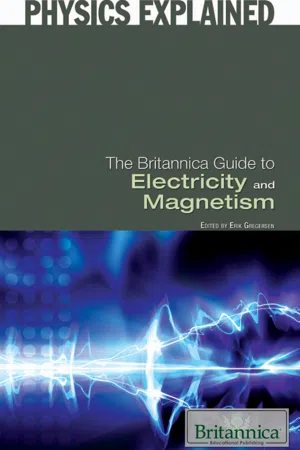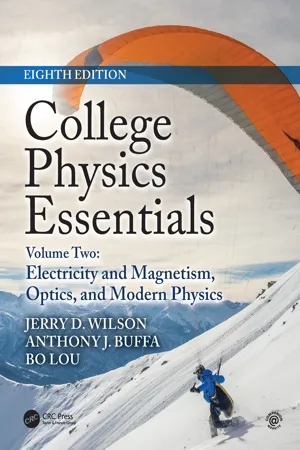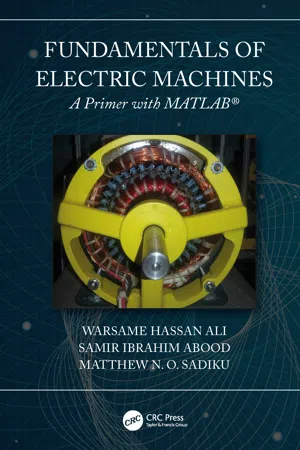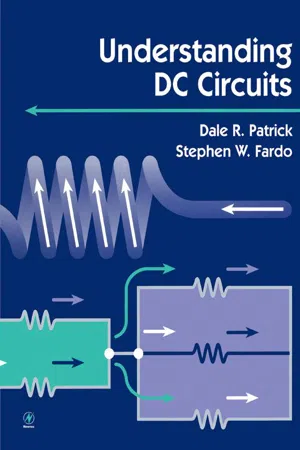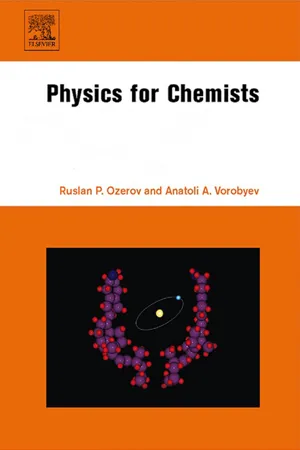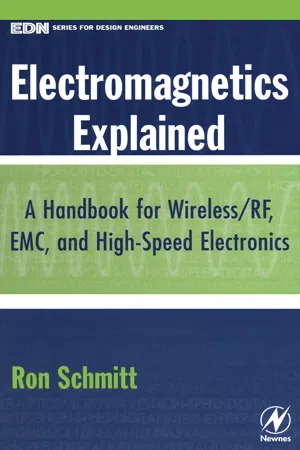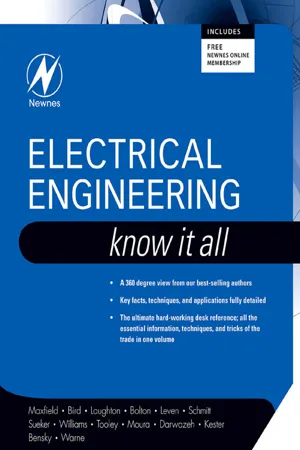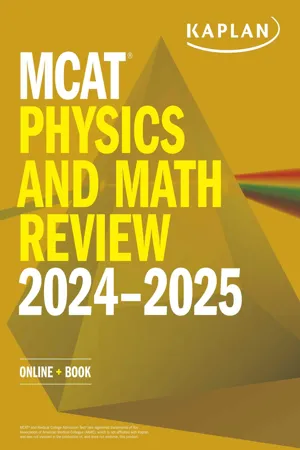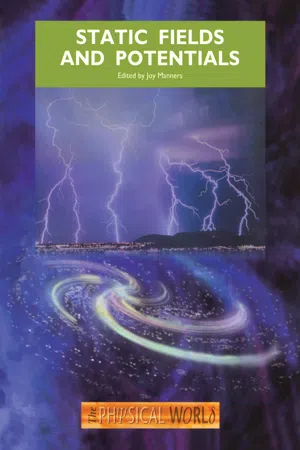Physics
Magnets
Magnets are objects that produce a magnetic field, attracting or repelling other magnets or magnetic materials. They have two poles, north and south, and can be used in various applications such as electric motors, generators, and compasses. The behavior of magnets is described by the laws of magnetism, which are fundamental to understanding electromagnetic phenomena.
Written by Perlego with AI-assistance
Related key terms
Related key terms
1 of 4
Related key terms
1 of 3
12 Key excerpts on "Magnets"
- Britannica Educational Publishing, Erik Gregersen(Authors)
- 2010(Publication Date)
- Britannica Educational Publishing(Publisher)
CHAPTER 4 MAGNETISMM agnetism is a phenomenon associated with the motion of electric charges. This motion can take many forms. It can be an electric current in a conductor or charged particles moving through space, or it can be the motion of an electron in atomic orbit. Magnetism is also associated with elementary particles, such as the electron, that have a property called spin.FUNDAMENTALS
Basic to magnetism are magnetic fields and their effects on matter, as, for instance, the deflection of moving charges and torques on other magnetic objects. Evidence for the presence of a magnetic field is the magnetic force on charges moving in that field; the force is at right angles to both the field and the velocity of the charge. This force deflects the particles without changing their speed. The deflection can be observed in the electron beam of a television tube when a permanent magnet is brought near the tube. A more familiar example is the torque on a compass needle that acts to align the needle with the magnetic field of Earth. The needle is a thin piece of iron that has been magnetized—i.e., a small bar magnet. One end of the magnet is called a north pole and the other end a south pole. The force between a north and a south pole is attractive, whereas the force between like poles is repulsive. The magnetic field is sometimes referred to as magnetic induction or magnetic flux density; it is always symbolized by B . Magnetic fields are measured in units of tesla (T). (Another unit of measure commonly used for B is the gauss, though it is no longer considered a standard unit. One gauss equals 10−4 tesla.)A fundamental property of a magnetic field is that its flux through any closed surface vanishes. (A closed surface is one that completely surrounds a volume.) This is expressed mathematically by div B = 0 and can be understood physically in terms of the field lines representing B- eBook - ePub
Developments in Data Storage
Materials Perspective
- S. N. Piramanayagam, Tow C. Chong(Authors)
- 2011(Publication Date)
- Wiley-IEEE Press(Publisher)
2 FUNDAMENTALS OF MAGNETISM Shiva Prasad Indian Institute of Technology, Bombay S. N. Piramanayagam Data Storage Institute, Singapore2.1 INTRODUCTIONEvery one of us has found fascination in Magnets in our childhood. What made them remarkable was that they showed both powers of attraction and repulsion. The “push” and “pull” exerted by Magnets not only make them interesting but also useful in a variety applications. It is hard to imagine a world without Magnets. From the fan of an air conditioner to the hard disk drive (HDD) where this chapter was stored while it was being written, many common appliances use Magnets. This chapter will provide the fundamentals of magnetism at a beginner’s level so that a person who is not familiar with magnetism can learn them and understand most of the other chapters, which assume a familiarity with basic magnetism. Concepts that are relevant to this book are being presented here rather than a comprehensive discussion of magnetism. A reader who wishes to learn more about magnetism might read the following books dedicated to this subject [1–4].2.2 THE ORIGIN OF ATOMIC MAGNETIC MOMENTMagnets were known to us for ages in the form of permanent Magnets. Eventually, they were used as navigation aids in the form of compass needles as Magnets tend to align north–south. The end of the magnet which points toward North is termed its north pole, and the one that points toward South is called its south pole. Like poles of two different Magnets repel each other, and unlike poles attract each other.In classical electrodynamics, magnetism is caused by electric current. Two types of electric charges, traditionally termed “positive” and “negative,” are found in nature. These charges can also show attraction and repulsion. Similar to magnetic poles, like charges repel whereas unlike charges attract each other. One of the major differences between electric charges and magnetic poles is that the charges can be isolated in the form of positive or negative charges, whereas the same cannot be done with magnetic poles. In any single magnet, if one end is its north pole, the other end is its south pole. If we break a magnet, we create two smaller Magnets, each with both a north pole and a south pole. Hence, we often use the term “dipole” for a magnet. - eBook - ePub
College Physics Essentials, Eighth Edition
Electricity and Magnetism, Optics, Modern Physics (Volume Two)
- Jerry D. Wilson, Anthony J. Buffa, Bo Lou(Authors)
- 2019(Publication Date)
- CRC Press(Publisher)
When thinking about magnetism, most people tend to envision an attractive force, because it is well known that certain materials can be picked up with a magnet. For example, paper clips are attracted to a magnet, and you have probably seen souvenir Magnets that can stick to a refrigerator. It is less likely, however, that a repulsive magnetic force would come to mind. But there are repulsive magnetic forces, and they can be as useful as attractive ones. In this regard, the chapter-opening photo shows an interesting example. At first glance, the vehicle looks like an ordinary train. But where are its wheels? In fact, it isn’t a conventional train, but a high-speed, magnetically levitated one. It doesn’t physically touch the rails; rather, it “floats” above them, supported by repulsive forces produced by powerful Magnets. The advantages are obvious: with no wheels, there is no rolling friction and few moving parts.But where do these magnetic forces come from? For centuries, the properties of Magnets were attributed to the supernatural. The original “natural” Magnets, called lodestones , were found in the ancient Greek province of Magnesia. Magnetism was later discovered to be associated with electricity in an area of study that is now called electromagnetism . The forces described by electromagnetism are routinely used in such applications as motors and generators.It is now known that electricity and magnetism are actually different manifestations of the same force. However, initially it is instructive to consider them individually. 19.1 Permanent Magnets, Magnetic Poles, and Magnetic FieldOne of the features of a common bar magnet is that it has two “centers of force,” called poles , near each end (▼ Figure 19.1 ). To avoid confusion with the ± designation used for electric charge, magnetic poles are instead labeled north (N) and south (S). This terminology stems from the early use of the magnetic compass to determine direction. The north pole of a compass needle was historically defined as the north-seeking pole – that is, the end that points north on the Earth. The other end is south-seeking – that is, a south pole. A confusing result of this definition can result because the north pole of a compass needle is attracted to the Earth’s north polar region (that is, geographic north), which means that the geographic north area is actually a south magnetic pole. (See Section 19.8 for more details about the Earth’s magnetic field.)▲ Figure 19.1 Bar magnet The iron filings (acting as little compass needles) indicate the poles, or centers of force, of a common bar magnet. Determination of the type of pole at each end is found using a compass (see Figure 19.3 - eBook - ePub
Magnet Therapy
The Gentle and Effective Way to Balance Body Systems
- Ghanshyam Singh Birla, Colette Hemlin(Authors)
- 1999(Publication Date)
- Healing Arts Press(Publisher)
Chapter ThreePROPERTIES OF MagnetsNow that we have looked at the origins and composition of Magnets, we will explore their physical properties—characteristics that apply to all Magnets, regardless of their origin, size, composition, or strength. However, it is necessary to explain some basic terms of magnetism before we examine those properties in detail.Magnetic field: A magnet (or an electric wire with current passing through it) is surrounded by a field that attracts objects. This is called the magnetic field.Magnetic induction: The basic vectorial dimension used to describe the magnetic field is known as magnetic induction and is described in terms of length and direction. Graphically, magnetic induction is represented by induction lines (just as force lines represent an electric field).Induction lines: These are drawn so that the number of lines per the surface area perpendicular to them is proportional to the intensity of the field. This means that tightly grouped lines represent a strong field, whereas more sparsely placed lines represent a weak field.Magnetic strength: The number of lines per given surface area determines the strength of a magnet. For instance, a 1,000-gauss magnet is stronger than a 500gauss magnet and can attract more iron. (Please note that in physics, the terms “strength” and “power” are not synonymous. However, for our purposes it is not necessary to explain the sometimes complex difference between these two concepts.)Flux: The flow of magnetic energy that circulates is known as the flux of the magnet.PHYSICAL PROPERTIES OF MagnetsYou have no doubt observed that the attraction-and-repulsion phenomenon can take place at a certain distance from a magnet. As indicated above, the zone in which a magnet produces its effect is called the magnetic field. We will discuss this field later in more detail. However, for now, we will examine the main magnetic effects existing in this field. - eBook - ePub
Fundamentals of Electric Machines: A Primer with MATLAB
A Primer with MATLAB
- Warsame Hassan Ali, Matthew N. O. Sadiku, Samir Abood(Authors)
- 2019(Publication Date)
- CRC Press(Publisher)
1 Basic Concepts of Magnetism I am a slow walker, but I never walk backwards.Abraham LincolnMagnetism is a force generated in the matter by the motion of electrons within its atoms. Magnetism and electricity represent different aspects of the force of electromagnetism, which is one part of nature’s fundamental magnetic force. The region in space that is penetrated by the imaginary lines of magnetic force describes a magnetic field. The strength of the magnetic field is determined by the number of lines of force per unit area of space. Magnetic fields are created on a large scale either by the passage of an electric current through magnetic metals or by magnetized materials called Magnets. The elemental metals—iron, cobalt, nickel, and their solid solutions or alloys with related metallic elements—are typical materials that respond strongly to magnetic fields. Unlike the all-pervasive fundamental force field of gravity, the magnetic force field within a magnetized body, such as a bar magnet, is polarized—that is, the field is strongest and of opposite signs at the two poles of the magnet.1.1 History of MagnetismThe history of magnetism was dated to earlier than 600 B.C., but it is only in the twentieth century that scientists have begun to understand it and develop technologies based on this understanding. Magnetism was most probably first observed in a form of the mineral magnetite called lodestone, which consists of an iron oxide—a chemical compound of iron and oxygen. The ancient Greeks were the first known to have used this mineral, which they called a magnet because of its ability to attract other pieces of the same material and iron.The British physicist William Gilbert (1600 B.C.) explained that the earth itself is a giant magnet with magnetic poles that are somewhat distracted from its geographical poles. The German scientist Gauss then studied the nature of earth’s magnetism, followed by the French scientist Koldem (1821 A.C.) known that the magnet is a ferrous material only. - eBook - ePub
Functional Molecular Materials
An Introductory Textbook
- Matteo Atzori, Flavia Artizzu(Authors)
- 2018(Publication Date)
- Jenny Stanford Publishing(Publisher)
This is one of the most ancient scientific subjects and one of the most difficult to understand. Closely connected with magnetism is magnetochemistry. This is a field of chemical physics that deals with magnetic measurements performed on chemical compounds, both molecular and atom based, as a tool to get information on their chemical structure. Finally molecular magnetism can be defined as a relatively new field of physics born to describe and understand the magnetic properties shown by magnetic molecular materials. 1 A deep knowledge of these three disciplines allows one to design new materials with expected magnetic properties and to understand their magnetic behaviors. The following sections describe their fundamental principles, with particular attention to those classes of materials that will be the theme of Chapter 3. 2.1.1 Magnetic Field One of the fundamental principles in magnetism is the concept of “magnetic field.” A magnetic field is produced whenever there is a charge in motion. This can be associated with an electrical current flowing in a conductor as was first discovered in 1819 by Oersted, or it can be generated by a permanent magnet. In the latter case there is no conventional electric current, but the orbital and spin motions of the electrons forming the permanent magnet lead to a magnetization within the material and to magnetic field generation. When a magnetic field is generated in a certain volume of space, an energy gradient is established and a force is produced - eBook - ePub
- Dale Patrick, Stephen Fardo(Authors)
- 1999(Publication Date)
- Newnes(Publisher)
Bars or other shapes of materials that retain their magnetic properties.Permeability (μ) The ability of a material to conduct magnetic lines of force as compared with air; the ability of a material to magnetize or demagnetize.PolaritiesSee magnetic poles .Relay An electromagnetic switch that uses a low current to control a higher-current circuit.Reluctance (ℜ) The opposition of a material to the flow of magnetic flux.Residual magnetism The magnetism that remains around a material after the magnetizing force has been removed.Retentivity The ability of a material to retain magnetism after a magnetizing force has been removed.Solenoid An electromagnetic coil with a metal core that moves when current passes through the coil.Permanent Magnets
Magnets are made of iron, cobalt, or nickel, usually in an alloy combination. An alloy is a mixture of these materials. Each end of the magnet is called a pole . If a magnet were broken, each part would become a magnet. Each magnet would have two poles. Magnetic poles are always in pairs. When a magnet is suspended in air so that it can turn freely, one pole will point to the North Pole. The earth is like a large permanent magnet. This is why compasses can be used to determine direction. The north pole of a magnet attracts the south pole of another magnet. A north pole repels another north pole and a south pole repels another south pole. The two laws of magnetism are (1) like poles repel and (2) unlike poles attract.The magnetic field patterns that exist when two permanent Magnets are placed end to end are shown in Fig. 4-1 . When the Magnets are farther apart, a smaller force of attraction or repulsion exists. This type of permanent magnet is called a bar magnetFigure 4-1 Magnetic field patterns that exist when Magnets are placed end to end,Some materials retain magnetism longer than others do. Hard steel holds its magnetism much longer than soft steel does. A magnetic field is set up around any magnetic material. The field is made up of lines of force , or magnetic flux . These magnetic flux lines are invisible. They never cross one another, but they always form individual closed loops around a magnetic material. They have a definite direction from north to south pole along the outside of a magnet. When magnetic flux lines are close together, the magnetic field is strong. When magnetic flux lines are farther apart, the field is weaker. The magnetic field is strongest near the poles. Lines of force pass through all materials. It is easy for lines of force to pass through iron and steel. Magnetic flux passes through a piece of iron as shown in Fig. 4-2 - eBook - ePub
- Ruslan P. Ozerov, Anatoli A. Vorobyev(Authors)
- 2007(Publication Date)
- Elsevier Science(Publisher)
5Magnetics
Publisher Summary
All magnetic materials can be divided into three main classes: diamagnetic, paramagnetic, and magnetically ordered substances. Diamagnetics are pushed out of an external nonuniform magnetic field; they consist of those molecules that do not possess their own magnetic dipole moments. Paramagnetics are drawn into the external nonuniform magnetic field; they consist of molecules possessing inherent magnetic dipole moments in the absence of an internal magnetic field. Ferromagnetics and ferrimagnetics are among the magnetically ordered substances and are highly reacting on an external magnetic field. There is also a class of antiferromagnetic substances, weakly reacting on an external field. This chapter describes the nature of all these substances and considers the characteristics that describe macro- and microproperties of magnetics. There are three sources of the magnetic properties of substances: electron spin, orbital electron motion, and change of the electron orbital angular momentum at the imposition of an external magnetic field. The first two can explain paramagnetism and the third can be used in considering diamagnetism.Before describing the magnetic properties of a chemical substance we will briefly discuss some of the properties of a magnetic field itself. Whereas the sources of an electrostatic field are motionless electric charges, the sources of a magnetic field are moving charges, i.e., an electric current. Let us consider some characteristics of a permanent electric current and the conditions of its maintenance.5.1 GENERAL CHARACTERISTICS OF THE MAGNETIC FIELD
5.1.1 A permanent (direct) electric current
An electric current can run in a substance in which free charges (current carriers ) are present. They can be either electrons (in metals, for example) or ions (in liquids or solid electrolytes). Such substances are referred to as the conductors - eBook - ePub
Electromagnetics Explained
A Handbook for Wireless/ RF, EMC, and High-Speed Electronics
- Ron Schmitt(Author)
- 2002(Publication Date)
- Newnes(Publisher)
Chapter 6 , you will learn more about the vector potential when we discuss quantum physics.MAGNETIC MATERIALS
Diamagnetism
In Chapter 2 , you learned that different materials behave differently in electric fields. You learned about conductors and dielectrics. Electric fields induce reactions in materials. In conductors, charges separate and nullify the field within the conductor. In dielectrics, atoms or molecules rotate or polarize to reduce the field. Magnetic fields also induce reactions in materials. However, since there are no magnet charges, there is no such thing as a “magnetic conductor.” All materials react to magnetic fields similarly to the way dielectrics react to electric fields. To be precise, magnetic materials usually interact with an external magnetic field via dipole rotations at the atomic level. For a simple explanation, you can think of an atom as a dense positive nucleus with light electrons orbiting the nucleus, an arrangement reminiscent of the planets orbiting the sun in the solar system. Another similar situation is that of a person swinging a ball at the end of a string. In each situation, the object is held in orbit by a force that points toward the orbit center. This type of force is called a centripetal force. The force is conveyed by electricity, gravity, or the string tension, respectively, for the three situations. Referring to Figure 3.17 and using the cross product right hand rule, you find that the force due to the external magnetic field points inward, adding to the centripetal force. The increase in speed increases the electron’s magnetic field, which is opposite to the external field. The net effect is that the orbiting electron tends to cancel part of the external field. Just as the free electron rotates in opposition to a magnetic field, the orbiting electron changes to oppose the magnetic field. This effect is called diamagnetism - eBook - ePub
- Clive Maxfield, John Bird, Tim Williams, Walt Kester, Dan Bensky(Authors)
- 2011(Publication Date)
- Newnes(Publisher)
Magnetic fields also induce reactions in materials. However, since there are no magnet charges, there is no such thing as a “magnetic conductor.” All materials react to magnetic fields similarly to the way dielectrics react to electric fields. To be precise, magnetic materials usually interact with an external magnetic field via dipole rotations at the atomic level. For a simple explanation, you can think of an atom as a dense positive nucleus with light electrons orbiting the nucleus, an arrangement reminiscent of the planets orbiting the sun in the solar system. Another similar situation is that of a person swinging a ball at the end of a string. In each situation, the object is held in orbit by a force that points toward the orbit center. This type of force is called a centripetal force. The force is conveyed by electricity, gravity, or the string tension, respectively, for the three situations. Referring to Figure 21.17 and using the cross product right hand rule, you find that the force due to the external magnetic field points inward, adding to the centripetal force. The increase in speed increases the electron’s magnetic field, which is opposite to the external field. The net effect is that the orbiting electron tends to cancel part of the external field. Just as the free electron rotates in opposition to a magnetic field, the orbiting electron changes to oppose the magnetic field. This effect is called diamagnetism and is just like that of dielectrics, where the dielectrics tend to reduce the applied electric field. The major difference here is that diamagnetism is an extremely weak effect. Even though all materials exhibit diamagnetism, the effect is so weak that you can usually ignore it. This explains the commonly known fact that most materials are not affected by Magnets. Figure 21.17 (a) A circulating electron in which the magnetic moment points upward; (b) Applying a downward magnetic field increases the upward moment of the electron - No longer available |Learn more
MCAT Physics and Math Review 2024-2025
Online + Book
- (Author)
- 2023(Publication Date)
- Kaplan Test Prep(Publisher)
Magnetic fields may be set up by the movement of individual charges, such as an electron moving through space; by the mass movement of charge in the form of a current though a conductive material, such as a copper wire; or by permanent Magnets. The SI unit for magnetic field strength is the tesla (T), where 1 T = 1 N ⋅ s m ⋅ C. The size of the tesla unit is quite large, so small magnetic fields are sometimes measured in gauss, where 1 T = 10 4 gauss. KEY CONCEPT Any moving charge, whether a single electron traveling through space or a current through a conductive material, creates a magnetic field. The SI unit for magnetic field strength is the tesla (T). All materials can be classified as diamagnetic, paramagnetic, or ferromagnetic. Diamagnetic materials are made of atoms with no unpaired electrons and that have no net magnetic field. These materials are slightly repelled by a magnet and so can be called weakly antimagnetic. Diamagnetic materials include common materials that you wouldn’t expect to get stuck to a magnet: wood, plastics, water, glass, and skin, just to name a few. The atoms of both paramagnetic and ferromagnetic materials have unpaired electrons, so these atoms do have a net magnetic dipole moment, but the atoms in these materials are usually randomly oriented so that the material itself creates no net magnetic field. Paramagnetic materials will become weakly magnetized in the presence of an external magnetic field, aligning the magnetic dipoles of the material with the external field. Upon removal of the external field, the thermal energy of the individual atoms will cause the individual magnetic dipoles to reorient randomly. Some paramagnetic materials include aluminum, copper, and gold. Ferromagnetic materials, like paramagnetic materials, have unpaired electrons and permanent atomic magnetic dipoles that are normally oriented randomly so that the material has no net magnetic dipole - eBook - ePub
- Joy Manners(Author)
- 2020(Publication Date)
- CRC Press(Publisher)
−3 T. This is sufficient to strongly magnetize some iron in the centre of the coil, and it is the magnetic field of the magnetized iron which is utilized. As the current in the coil is changed, the magnetization of the iron changes and the field produced is roughly proportional to the current in the coil, up to some maximum current at which the iron is fully magnetized — i.e. all the domains are aligned.Figure 4.44 Illustration of the operation of an electromagnet, (a) A current through a solenoidal coil of wire generates a small magnetic field, (b) If a solenoidal coil is wrapped around a soft magnetic material, then the material becomes strongly magnetized even by the small applied field.Hard magnetic materials
Permanent Magnets are examples of hard magnetic materials. The fabrication of strong permanent Magnets is a complex process, but from our point of view we need to notice only one thing: the key requirement is for a material in which domain wall motion is very difficult. Thus when a parallel arrangement of domains is created — generally by the application of strong magnetic fields and high temperatures — the arrangement is unable to change.Although permanent Magnets are common in all kinds of devices, perhaps the most important application is as a component in small powerful motors. These are now commonplace in many technological devices. For example, many modern cameras have an autofocus lens driven by a motor, and another motor automatically winds on the film after each exposure and finally rewinds it. Motors are essential whenever a low-power device does mechanical work of any kind. The physical principles underlying the operation of such motors are discussed in Dynamic fields and waves.Magnetic media
Cassette tapes and computer disks are examples of magnetic media. The requirements for such media are that they should become fairly easily magnetized, and yet retain their magnetization so as to preserve the information recorded. Indeed, signals recorded onto magnetic media are stable for periods as long as a few decades. The design of such materials involves the use of particles that are so small that within each particle there is room for only one magnetic domain. In such circumstances, the magnetization process does not involve the motion of domain walls, but the rotation of the magnetization of the individual particles of the magnetic powder.
Index pages curate the most relevant extracts from our library of academic textbooks. They’ve been created using an in-house natural language model (NLM), each adding context and meaning to key research topics.
Explore more topic indexes
Explore more topic indexes
1 of 6
Explore more topic indexes
1 of 4
